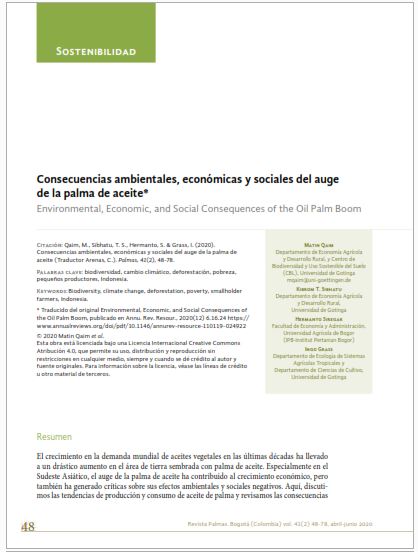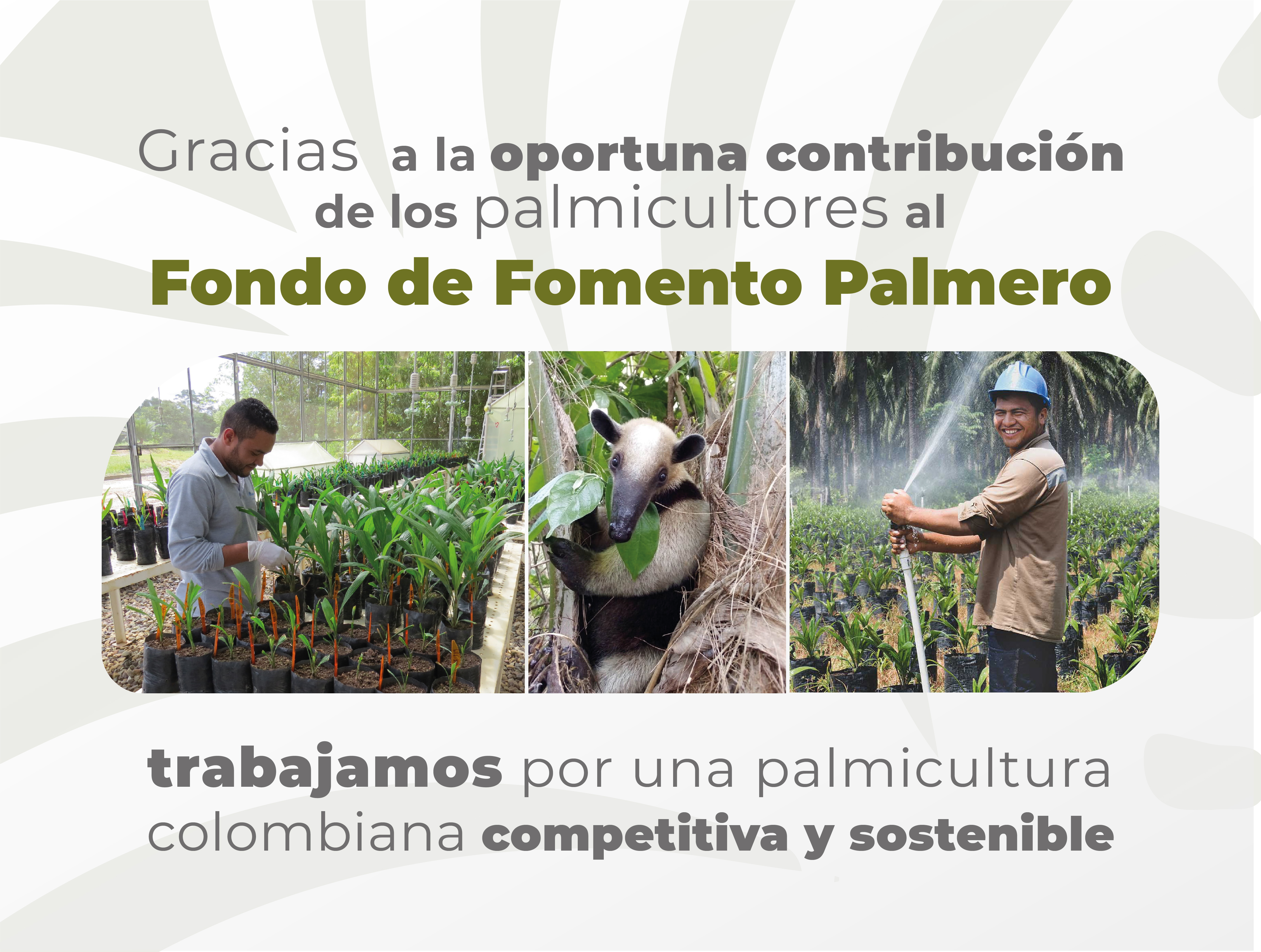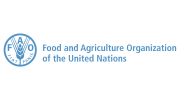Consecuencias ambientales, económicas y sociales del auge de la palma de aceite
Palabras clave:
biodiversidad, cambio climático, deforestación, pobreza, pequeños productores, IndonesiaResumen
El crecimiento en la demanda mundial de aceites vegetales en las últimas décadas ha llevado a un drástico aumento en el área de tierra sembrada con palma de aceite. Especialmente en el Sudeste Asiático, el auge de la palma de aceite ha contribuido al crecimiento económico, pero también ha generado críticas sobre sus efectos ambientales y sociales negativos. Aquí, discutimos las tendencias de producción y consumo de aceite de palma y revisamos las consecuencias ambientales, económicas y sociales en varias partes del mundo. La expansión de la palma de aceite ha contribuido a la deforestación tropical y a pérdidas asociadas a la biodiversidad y las funciones del ecosistema. Simultáneamente, ha aumentado los ingresos, generado empleo y reducido la pobreza en hogares agrícolas y no agrícolas. Cerca del 50 % de la tierra sembrada con palma de aceite en el mundo es administrada por pequeños productores. Es necesario reducir la disyuntiva de sostenibilidad entre la preservación de los bienes ambientales públicos mundiales y los beneficios económicos privados. Discutimos las implicaciones de políticas relacionadas con el crecimiento de la productividad, la protección de la selva tropical, el mosaico del paisaje, los derechos de propiedad de la tierra, la certificación de sostenibilidad y la inclusión de pequeños productores, entre otros.
Referencias bibliográficas
Abrams J., Pischke EC., Mesa-Jurado MA., Eastmond A., Silva CA., Moseley C. 2019. Between environmental change and neoliberalism: the effects of oil palm production on livelihood resilience. Soc. Nat. Resour. 32:548-65.
Ahmed A., Dompreh E., Gasparatos A. 2019. Human wellbeing outcomes of involvement in industrial crop production: evidence from sugarcane, oil palm and jatropha sites in Ghana. PLOS ONE 14:e0215433 .
Alwarritzi W., Nanseki T., Chomei Y. 2016. Impact of oil palm expansion on farmers’ crop income and poverty reduction in Indonesia: an application of propensity score matching. J. Agric. Sci. 8:119-31.
Andrianto A., Komarudin H., Pacheco P. 2019. Expansion of oil palm plantations in Indonesia’s frontier: problems of externalities and the future of local and indigenous communities. Land 8:56.
Aratrakorn S., Thunhikorn S., Donald PF. 2006. Changes in bird communities following conversion of lowland forest to oil palm and rubber plantations in southern Thailand. Bird Conserv. Int. 16:71-82.
Awusabo-Asare K., Tanle A. 2008. Eking a living: women entrepreneurship and poverty reduction strategies: the case of palm kernel oil processing in the Central Region of Ghana. Nor. J. Geogr. 62(3):149-60.
Azhar B., Saadun N., Prideaux M., Lindenmayer DB. 2017. The global palm oil sector must change to save biodiversity and improve food security in the tropics. J. Environ. Manag.
203:457-66.
Balde B., Diawara M., Rossignoli C., Gasparatos A. 2019. Smallholder-based oil palm and rubber production in the forest region of Guinea: an exploratory analysis of household food security outcomes. Agriculture 9(2):41.
Barnes AD., Jochum M., Mumme S., Haneda NF., Farajallah A., et al. 2014. Consequences of tropical land use for multitrophic biodiversity and ecosystem functioning. Nat. Commun.
5:5351.
Baudoin A., Bosc P-M., Bessou C., Levang P. 2017. Review of the Diversity of Palm Oil Production Systems in Indonesia: Case Study of Two Provinces, Riau and Jambi. Bogor, Indones.: CIFOR.
Benami E., Curran LM., Cochrane M., Venturieri A., Franco R., et al. 2018. Oil palm land conversion in Pará, Brazil, from 2006-2014: evaluating the 2010 Brazilian sustainable palm oil production program. Environ. Res. Lett. 13:34037.
Bennett A., Ravikumar A., McDermott C., Malhi Y. 2019. Smallholder oil palm production in the Peruvian Amazon: rethinking the promise of associations and partnerships for economically sustainable livelihoods. Front. Un. Glob. Change 2:14.
Bou Dib J., Alamsyah Z., Qaim M. 2018a. Land-use change and income inequality in rural Indonesia. Un. Policy Econ. 94:55-66.
Bou Dib J., Krishna VV., Alamsyah Z., Qaim M. 2018b. Land-use change and livelihoods of non-farm households: the role of income from employment in oil palm and rubber in rural Indonesia. Land Use Policy 76:828-38.
Brandi C., Cabani T., Hosang C., Schirmbeck S., Westermann L., Wiese H. 2015. Sustainability standards for palm oil. J. Environ. Dev. 24:292-314.
Brinkmann N., Schneider D., Sahner J., Ballauff J., Edy N., et al. 2019. Intensive tropical land use massively shifts soil fungal communities. Sci. Rep. 9:3403.
Byerlee D., Falcon WP., Naylor R. 2017. The Tropical Oil Crop Revolution: Food, Feed, Fuel, and Forests. New York: Oxford Univ. Press.
Cahyadi ER., Waibel H. 2016. Contract farming and vulnerability to poverty among oil palm smallholders in Indonesia. J. Dev. Stud. 52:681-95.
Canfield LM., Kaminsky RG., Taren DL., Shaw E., Sander JK. 2001. Red palm oil in the maternal diet increases provitamin A carotenoid in breastmilk and serum of the mother- infant dyad. Eur. J. Nutr. 40:30-38.
Carlson KM., Curran LM., Ratnasari D., Pittman AM., Soares-Filho BS., etal. 2012. Committed carbon emissions, deforestation, and community land conversion from oil palm plantation expansion in West Kalimantan, Indonesia. PNAS 109(19):7559-64.
Carlson KM., Garrett RD. 2018. Environmental impacts of tropical soybean and palm oil crops. In Oxford Research Encyclopedia of Environmental Science. https://doi.org/10.1093/acrefore/9780199389414.013. 234
Carlson KM., Heilmayr R., Gibbs HK., Noojipady P., Burns DN., et al. 2018. Effect of oil palm sustainability certification on deforestation and fire in Indonesia. PNAS 115:121-26.
Carrere R. 2013. Oil palm in Africa: past, present and future scenarios. Rep., WRM Ser. Tree Plant. 15, Montevideo, Urug.
Castellanos-Navarrete A., Tobar-Tomás WV., López-Monzón CE. 2019. Development without change: oil palm labour regimes, development narratives, and disputed moral economies in Mesoamerica. J. Rural Stud. 71:169-80.
Castiblanco C., Etter A. Ramírez A. 2015. Impacts of oil palm expansion in Colombia: What do socioeconomic indicators show? Land Use Policy 44:31-43.
Chrisendo D., Krishna VV., Siregar H., Qaim M. 2019. Land-use change, nutrition, and gender roles in Indonesian farm households. EFForTS Discuss. Pap. 24, Univ. Goettingen.
Clough Y., Krishna VV., Corre MD., Darras K., Denmead LH., et al. 2016. Land-use choices follow profitability at the expense of ecological functions in Indonesian smallholder landscapes. Nat. Commun. 7:13137.
Cohn AS., Newton P., Gil JDB., Kuhl L., Samberg L., et al. 2017. Smallholder agriculture and climate change. Annu. Rev. Environ. Resour. 42:347-75.
Colchester M. 2011. Palm Oil and Indigenous Peoples of South East Asia: Land Acquisition, Human Rights Violations and Indigenous Peoples on the Palm Oil Frontier. Moreton-in- Marsh, UK/Rome: Un. Peoples Prog./Int. Land Coalit.
Comte I., Colin F., Whalen JK., Grünberger O., Caliman JP. 2012. Agricultural practices in oil palm plantations and their impact on hydrological changes, nutrient fluxes and water quality in Indonesia: a review. Adv. Agron. 116:71-124.
Corley RHV., Rao V., Palat T., Praiwan T. 2018. Breeding for drought tolerance oil palm. J. Oil Palm Res. 30:26-35.
Corley RHV., Tinker PB. 2016. The Oil Palm. Chichester, UK: Wiley Blackwell. 5th ed.
Cramb R., Curry GN. 2012. Oil palm and rural livelihoods in the Asia-Pacific region: an overview. Asia Pac. Viewp. 53:223-39.
Darras K., Corre MD., Formaglio G., Aiyen T., Potapov A., et al. 2019. Reducing fertilizer and avoiding herbicides in oil palm plantations ecological and economic valuations. Front. For. Glob. Change. https://doi. org/10.3389/ffgc.2019.00065
Dauvergne P. 2018. The global politics of the business of “sustainable” palm oil. Glob. Environ. Politics 18:34-52.
Dislich C., Hettig E., Salecker J., Heinonen J., Lay J., et al. 2018. Land-use change in oil palm dominated tropical landscapes an agent-based model to explore ecological and socio- economic trade-offs. PLOS ONE 13:e0190506.
Dislich C., Keyel AC., Salecker J., Kisel Y., Meyer KM., et al. 2017. A review of the ecosystem functions in oil palm plantations, using forests as a reference system. Biol. Rev. Camb. Philos. Soc. 92(3):1539-69.
Drescher J., Rembold K., Allen K., Beckschäfer P., Buchori D., et al. 2016. Ecological and socioeconomic functions across tropical land-use systems after rainforest conversion. Philos. Trans. R. Soc. B 371:20150275.
Edwards FA., Edwards DP., Hamer KC., Davies RG. 2013. Impacts of logging and conversion of rainforest to oil palm on the functional diversity of birds in Sundaland. Ibis 155:313-26.
Edwards RB. 2019a. Export Agriculture and Rural Poverty: Evidence from Indonesian Palm Oil. Work. Pap., Dartmouth Coll., Hanover, NH.
Edwards RB. 2019b. Spillovers from Agricultural Processing. Work. Pap., Dartmouth Coll., Hanover, NH.
Euler M., Hoffmann M., Fathoni Z., Schwarze S. 2016b. Exploring yield gaps in smallholder oil palm production systems in eastern Sumatra, Indonesia. Agric. Syst. 146:111-19.
Euler M., Krishna VV., Schwarze S., Siregar H., Qaim M. 2017. Oil palm adoption, household welfare, and nutrition among smallholder farmers in Indonesia. World Dev. 93:219-35.
Euler M., Schwarze S., Siregar H., Qaim M. 2016a. Oil palm expansion among smallholder farmers in Sumatra, Indonesia. J. Agric. Econ. 67:658-76.
FAO (Organización de las Naciones Unidas para la Agricultura y la Alimentación). 2019. Crops. FAOSTAT statistical database, Rome, updated March 4, 2020. http:// www.fao.org/
faostat/en/#data/QC
Fargione J., Hill J., Tilman D., Polasky S., Hawthorne P. 2008. Land clearing and the biofuel carbon debt. Science 319:1235-38.
Fattore E., Bosetti C., Brighenti F., Agostoni C., Fattore G. 2014. Palm oil and blood lipid- related markers of cardiovascular disease: a systematic review and meta-analysis of dietary intervention trials. Am. J. Clin. Nutr. 99:1331-50.
Fearnside PM. 1997. Transmigration in Indonesia: lessons from its environmental and social impacts. Environ. Manag. 21:553-70.
Feintrenie L., Chong WK., Levang P. 2010. Why do farmers prefer oil palm? Lessons learnt from Bungo District, Indonesia. Small-Scale For. 9:379-96.
Fitzherbert EB., Struebig MJ., Morel A., Danielsen F., Brühl CA., et al. 2008. How will oil palm expansion affect biodiversity? Trends Ecol. Evol. 23:538-45.
Fitzpatrick D. 1997. Disputes and pluralism in modern Indonesian land law. Yale J. Int. Law 22:170-212.
Foster WA., Snaddon JL., Turner EC., Fayle TM., Cockerill TD., et al. 2011. Establishing the evidence base for maintaining biodiversity and ecosystem function in the oil palm landscapes of South East Asia. Philos. Trans. R. Soc. B 366:3277-91.
Furumo PR., Aide TM. 2017. Characterizing commercial oil palm expansion in Latin America: land use change and trade. Environ. Res. Lett. 12:024008.
Garrett RD., Carslon KM., Rueda X., Noojipady P. 2016. Assessing the potential additionality of certification by the Round Table on Responsible Soybeans and the Roundtable on Sustainable Palm Oil. Environ. Res. Lett. 22:045003.
Gatto M., Wollni M., Asnawi R., Qaim M. 2017. Oil palm boom, contract farming, and rural economic development: village-level evidence from Indonesia. World Dev. 95:127-40.
Gatto M., Wollni M., Qaim M. 2015. Oil palm boom and land-use dynamics in Indonesia: the role of policies and socioeconomic factors. Land Use Policy 46:292-303.
Gaveau DLA., Sheil D., Husnayaen Salim MA., Arjasakusuma S., et al. 2016. Rapid conversions and avoided deforestation: examining four decades of industrial plantation expansion in Borneo. Sci. Rep. 6:32017.
Gerard A., Wollni M., Hölscher D., Irawan B., Sundawati L., et al. 2017. Oil yields in diversified plantations: initial results from a biodiversity enrichment experiment in Sumatra, Indonesia. Agric. Ecosyst. Environ. 240:253-60.
Giam X., Hadiaty RK., Tan HH., Parenti LR., Wowor D., et al. 2015. Mitigating the impact of oil-palm monoculture on freshwater fishes in Southeast Asia. Conserv. Biol. 29:1357-67.
Gibbs HK., Rausch L., Munger J., Schelly I., Morton DC., et al. 2015. Brazil’s soy moratorium.
Science 347:377-78.
Gibbs HK., Ruesch AS., Achar M., Claytond K., Holmgren P., et al. 2010. Tropical forests were the primary sources of new agricultural land in the 1980s and 1990s. PNAS
107:16732-37.
Grass I., Kubitza C., Krishna VV., Corre MD., Mußhoff O., et al. 2020. Trade-offs between multifunctionality and profit in tropical smallholder landscapes. Nat. Commun. 11:1186.
Grass I., Loos J., Baensch S., Batáry P., Librán-Embid F., et al. 2019. Land-sharing/-sparing connectivity landscapes for ecosystem services and biodiversity conservation. People Nat.
1:262-72.
Green Livelihoods Alliance. 2019. Impacts and Implications of Oil Palm on Landscapes and Livelihoods in Uganda’s Lake Victoria Islands—an Overview of Recent Research. Policy Brief, July. Green Livelihoods Alliance, Wageningen, Neth.
Guillaume T., Kotowska MM., Hertel D., Knohl A., Krashevska V., et al. 2018. Carbon costs and benefits of Indonesian rainforest conversion to plantations. Nat. Commun. 9:2388.
Hamann S. 2018. Agro-industrialisation and food security: dietary diversity and food access of workers in Cameroon’s palm oil sector. Can. J. Dev. Stud. 39:72-88.
Hartley CWS. 1988. The Oil Palm (Elaeis guineensis Jacq.). Harlow, UK: Longman Sci. Tech. 3rd ed.
Hervas A. 2018. Land,development and contract farming on the Guatemalan oil palm frontier. J. Peasant Stud. 46:115-41.
Hidayat NK., Offermans A., Glasbergen P. 2018. Sustainable palm oil as a public responsibility? On the governance capacity of Indonesian Standard for Sustainable Palm Oil (ISPO).
Agric. Hum. Values 35:223-42.
IUCN (Int. Union Conserv. Nat.). 2018. Oil Palm and Biodiversity: A Situation Analysis by the IUCN Oil Palm Task Force. Gland, Switz.: IUCN.
Jelsma I., Schoneveld GC., Zoomers A., van Westen ACM. 2017. Unpacking Indonesia’s independent oil palm smallholders: an actor-disaggregated approach to identifying environmental and social performance challenges. Land Use Policy 69:281-97.
Johnston FH., Henderson SB., Chen Y., Randerson JT., Marlier M., et al. 2012. Estimated global mortality attributable to smoke from landscape fires. Environ. Health Perspect. 120:695-701.
Katayama A., Kume T., Komatsu H. Saitoh TM., Ohashi M., et al. 2013. Carbon allocation in a Bornean tropical rainforest without dry seasons. J. Plant Res. 126(4):505-15.
Kho LK., Jepsen MR. 2015. Carbon stock of oil palm plantations and tropical forests in Malaysia: a review. Singap. J. Trop. Geogr. 36:249-66.
Klasen S., Meyer KM., Dislich C., Euler M., Faust H., et al. 2016. Economic and ecological trade-offs of agricultural specialization at different spatial scales. Ecol. Econ. 122:111-20.
Koh LP., Levang P., Ghazoul J. 2009. Designer landscapes for sustainable biofuels. Trends Ecol Evol. 24:431-38.
Kotowska MM., Leuschner C., Triadiati T., Meriem S., Hertel D. 2015. Quantifying above- and belowground biomass carbon loss with forest conversion in tropical lowlands of Sumatra (Indonesia). Glob. Change Biol. 21:3620-34.
Krashevska V., Klarner B., Widyastuti R., Maraun M., Scheu S. 2016. Changes in structure and functioning of protist (testate amoebae) communities due to conversion of lowland rainforest into rubber and oil palm plantations. PLOS ONE 11:e0160179.
Krishna VV., Euler M., Siregar H., Qaim M. 2017a. Differential livelihood impacts of oil palm expansion in Indonesia. Agric. Econ. 48:639-53.
Krishna VV., Kubitza C., Pascual U., Qaim M. 2017b. Land markets, property rights, and deforestation: insights from Indonesia. World Dev. 99:335-49.
Kubitza C., Bou Dib J., Kopp T., Krishna VV., Nuryanto N., et al. 2019. Labor Savings in Agriculture and Inequality at Different Spatial Scales: The Expansion of Oil palm in Indonesia. EFForTS Discuss. Pap. 26, Univ. Goettingen.
Kubitza C., Gehrke E. 2018. Why does a Labor-saving Technology Decrease Fertility Rates? Evidence fromthe Oil PalmBoomin Indonesia. EFForTS Discuss. Pap. 22, Univ. Goettingen.
Kubitza C., Krishna VV., Alamsyah Z., Qaim M. 2018a. The economics behind an ecological crisis: Livelihood effects of oil palm expansion in Sumatra, Indonesia. Hum. Ecol. 46: 107-16.
Kubitza C., Krishna VV., Urban K., Alamsyah Z., Qaim M. 2018b. Land property rights, agricultural intensification, and deforestation in Indonesia. Ecol. Econ. 147:312-21.
Kunz Y., Otten F., Mardiana R., Martens K., Roedel I., Faust H. 2019. Smallholder telecoupling and climate governance in Jambi Province, Indonesia. Soc. Sci. 8:4-115.
Laurance WF., Sayer J., Cassman KG. 2014. Agricultural expansion and its impacts on tropical nature. Trends Ecol. Evol. 29:107-16.
Lee JSH., Ghazoul J., Obidzinski K., Koh LP. 2014. Oil palm smallholder yields and incomes constrained by harvesting practices and type of smallholder management in Indonesia. Agron. Sustain. Dev. 34:501-13.
Lees AC., Moura NG., de Almeida AS., Vieira ICG. 2015. Poor prospects for avian biodiversity in Amazonian oil palm. PLOS ONE 10:e0122432.
Li TM. 2018. After the land grab: infrastructural violence and the “Mafia System” in Indonesia’s oil palm plantation zones. Geoforum 96:328-37.
Luskin MS., Albert WR., Tobler MW. 2017. Sumatran tiger survival threatened by deforestation despite increasing densities in parks. Nat. Commun. 8:1783.
Margono A., Potapov P., Turubanova S., Stolle F., Hansen M. 2014. Primary forest cover loss in Indonesia over 2000-2012. Nat. Clim. Change 4:730-35.
McCarthy J. 2010. Processes of inclusion and adverse incorporation: oil palm and agrarian change in Sumatra, Indonesia. J. Peasant Stud. 37:821-50.
McCarthy J, Cramb R. 2009. Policy narratives, landholder engagement, and oil palm expansion on the Malaysian and Indonesian frontiers. Geogr. J. 175:112-23.
MEA (Millenn. Ecosyst. Assess.). 2005. Ecosystems and Human Well-Being: Synthesis. Washington, DC: Island Press.
Meemken EM., Qaim M. 2018. Organic agriculture, food security, and the environment. Annu. Rev. Resour. Econ. 10:39-63.
Meijaard E., Sheil D. 2019. The moral minefield of ethical oil palm and sustainable development. Front. Un. Glob. Change 2:22 a.m.
Meijide A., Badu C., Moyano F., Tiralla N., Gunawan D., Knohl A. 2018. Impact of forest conversion to oil palm and rubber plantations on microclimate and the role of the 2015 ENSO event. Agric. Un. Meteorol. 252:208-19.
Merten J., Röll A., Guillaume T., Meijide A., Tarigan S., et al. 2016. Water scarcity and oil palm expansion: social views and environmental processes. Ecol. Soc. 21:2-5.
Mertz O., Mertens CF. 2017. Land sparing and land sharing policies in developing countries drivers and linkages to scientific debates. World Dev. 98:523-35.
Mingorría S., Gamboa G., Martín-López B., Corbera E. 2014. The oil palm boom: socio-economic implications for Q’eqchi’ households in the Polochic valley, Guatemala. Environ. Dev. Sustain. 16:841-71.
Morgans CL., Meijaard E., Santika T., Law E., Budiharta S., et al. 2018. Evaluating the effectiveness of palm oil certification in delivering multiple sustainability objectives. Environ. Res. Lett. 13:64032.
Moser C., Hildebrandt T., Bailis R. 2014. International sustainability standards and certification. En Sustainable Development of Biofuels in Latin America and the Caribbean, ed. BD Solomon, R Bailis, pp. 27-69. New York: Springer.
Mumme S., Jochum M., Brose U., Haneda NF., Barnes AD. 2015. Functional diversity and stability of litter invertebrate communities following land-use change in Sumatra, Indonesia. Biol. Conserv. 191:750-58.
Naylor RL., Higgins MM., Edwards RB., Falcon WP. 2019. Decentralization and the environment: assessing smallholder oil palm development in Indonesia. Ambio 48: 1195-208.
Nkongho RN., Feintrenie L., Levang P. 2014. The Non-Industrial Palm Oil Sector in Cameroon. Bogor, Indones.: CIFOR.
Obado J., Syaukat Y., Siregar H. 2009. The impacts of export tax policy on the Indonesian crude palm oil industry. ISSAAS 15(2):107-19.
Obidzinski K., Andriani R., Komarudin H., Andrianto A. 2012. Environmental and social impacts of oil palm plantations and their implications for biofuel production in Indonesia. Ecol. Soc. 17:1-25.
Ohimain EI., Izah SC. 2014. Energy self-sufficiency of smallholder oil palm processing in Nigeria. Renew. Energy 63:426-31.
Okoro SU., Schickhoff U., Böhner J., Schneider UA. 2016. A novel approach in monitoring land-cover change in the tropics: oil palm cultivation in the Niger Delta, Nigeria. Die Erde 147:40-52.
Ordway EM., Naylor RL., Nkongho RN., Lambin EF. 2017. Oil palm expansion in Cameroon: insights into sustainability opportunities and challenges in Africa. Glob. Environ. Change 47:190-200.
Ordway EM., Naylor RL., Nkongho RN., Lambin EF. 2019. Oil palm expansion and deforestation in Southwest Cameroon associated with proliferation of informal mills. Nat. Commun. 10:114.
Osei-Amponsah C., Visser L., Adjei-Nsiah S., Struik PC., Sakyi-Dawson O., Stomph TJ. 2012.
Processing practices of small-scale palm oil producers in the Kwaebibirem District, Ghana: a diagnostic study. Wagening. J. Life Sci. 60-63:49-56.
Overbeek W., Kröger M., Gerber J-F. 2012. An Overview of Industrial Tree Plantation Conflicts in the Global South: Conflicts, Trends, and Resistance Struggles. EJOLT Rep. 3, Barcelona.
Paoletti A., Darras K., Jayanto H., Grass I., Kusrini M, Tscharntke T. 2018. Amphibian and reptile communities of upland and riparian sites across Indonesian oil palm, rubber and forest. Glob. Ecol. Conserv. 16:e00492.
Persch-Orth M., Mwangi E. 2016. Company-Community Conflict in Indonesia’s Industrial Plantation Sector. Bogor, Indones.: CIFOR.
Pirker J., Mosnier A., Kraxner F., Havlik P., Obersteiner M. 2016. What are the limits to oil palm expansion? Glob. Environ. Change 40:73-81.
Potter LM. 2018. Alternative pathways for smallholder oil palm in Indonesia. In The Oil Palm Complex: Smallholders, Agribusiness and the State in Indonesia and Malaysia, ed. R Cramb, JF McCarthy, pp. 155-88. Singapore: NUS Press.
Prabowo W., Darras K., Clough Y., Toledo-Hernandez M., Arlettaz R., etal. 2016. Bird responses to lowland rainforest conversion in Sumatran smallholder landscapes, Indonesia. PLOS ONE 11:e0154876.
Pye O. 2019. Commodifying sustainability: development, nature and politics in the palm oil industry. World Dev. 121:218-28.
Pyle JA., Warwick NJ., Harris NRP., Abas MR., Archibald AT., et al. 2011. The impact of local surface changes in Borneo on atmospheric composition at wider spatial scales: coastal processes, land-use change and air quality. Philos. Trans. R. Soc. B 366:3210-24.
Rembold K., Mangopo H., Sudarmiyati S., Kreft H. 2017. Plant diversity, forest dependency, and alien plant invasions in tropical agricultural landscapes. Biol. Conserv. 213:234-42
Rhebergen T., Fairhurst T., Zingore S., Fisher M., Oberthür T., Whitbread A. 2016. Climate, soil and land-use based land suitability evaluation for oil palm production in Ghana. Eur. J. Agron. 81:1-14.
Rist L., Feintrenie L., Levang P. 2010. The livelihood impacts of oil palm: smallholders in Indonesia. Biodivers. Conserv. 19:1009-24.
Ruml A, Qaim M. 2019. Effects of Marketing Contracts and Resource-providing Contracts in the African Small Farm Sector: Insights from Oil Palm Production in Ghana. Global Food Discuss. Pap. 130, Univ. Goettingen.
Saharjo BH., Munoz CP. 2005. Controlled burning in peat lands owned by small farmers: a case study in land preparation. Wetlands Ecol. Manag. 13:105-10.
Sahner J., Budi SW., Barus H., Edy N., Meyer M., et al. 2015. Degradation of root community traits as indicator for transformation of tropical lowland rain forests into oil palm and rubber plantations. PLOS ONE 10:e0138077.
Santika T., Wilson KA., Budiharta S., Law EA., Poh TM., et al. 2019a. Does oil palm agriculture help alleviate poverty? A multidimensional counterfactual assessment of oil palm development in Indonesia. World Dev. 120:105-17.
Santika T., Wilson KA., Meijaard E., Budiharta S., Law EE., et al. 2019b. Changing landscapes, livelihoods and village welfare in the context of oil palm development. Land Use Policy 87:31-104073.
Sayer J., Ghazoul J., Nelson P., Boedhihartono AK. 2012. Oil palm expansion transforms tropical landscapes and livelihoods. Glob. Food Secur. 1:114-19.
Schneider D., Engelhaupt M., Allen K., Kurniawan S., Krashevska V., etal. 2015. Impact of lowland rainforest transformation on diversity and composition of soil prokaryotic communities in Sumatra (Indonesia). Front. Microbiol. 6. https://doi.org/10.3389/fmicb.2015.01339
SchoneveldGC.,vanderHaarS.,EkowatiD.,AndriantoA.,KomarudinH., etal.2019.Certification, good agricultural practice and smallholder heterogeneity: differentiated pathways for resolving compliance gaps in the Indonesian oil palm sector. Glob. Environ. Change 57:101933.
Scriven S., Beale C., Benedick S., Hill J. 2017. Barriers to dispersal of rain forest butterflies in tropical agricultural landscape. Biotropica 49:206-16.
Sibhatu KT. 2019. Oil palm boom and farm household diets in the tropics. Front. Sustain. Food Syst. 3:75.
Sibhatu KT, Qaim M. 2018. Farm production diversity and dietary quality: linkages and measurement issues. Food Secur. 10:47-59.
Soliman T., Lim FKS., Lee JSH., Carrasco LR. 2016. Closing oil palm yield gaps among Indonesian smallholders through industry schemes, pruning, weeding and improved seeds. R. Soc. Open Sci. 3:160292.
Susanti W., Pollierer M., Widyastuti R., Scheu S, Potapov A. 2019. Conversion of rainforest to oil palm and rubber plantations alters energy channels in soil food webs. Ecol. Evol.
9:9027-39.
Susila WR. 2004. Contribution of oil palm industry to economic growth and poverty alleviation in Indonesia. J. Penelit. Pengemb. Pertan. 23(3):107-13.
Taheripour F., Hertel TW., Ramankutty N. 2019. Market-mediated responses confound policies to limit deforestation from oil palm expansion in Malaysia and Indonesia. PNAS 116:19193-99.
Tscharntke T., Milder JC., Schroth G., Clough Y., DeClerck F., et al. 2015. Conserving biodiversity through certification of tropical agroforestry crops at local and landscape scales. Conserv. Lett. 8:14 a.m. -23.
USDA (Departamento de Agricultura de EE. UU.). 2019. Oilseeds: World Markets and Trade. USDA Econ. Stat. Mark. Info. Syst., actualizado Feb. 2020. https://www.fas.usda.gov/data/
oilseeds-world-markets-and-trade
Valencia R., Balslev H., Paz y Mino G. 1994. High tree alpha-diversity in Amazonian Ecuador. Biodivers. Conserv. 8:21-28.
van Noordwijk M., Susswein PM., Tomich TP., Diaw C., Vosti S. 2001. Land Use Practices in the Humid Tropics and Introduction to ASB Benchmark Areas. Bogor, Indones.: ICRAF.
Villela A., Jaccoud D., Rosa L., Freitas M. 2014.Status and prospects of oil palm in the Brazilian Amazon. Biomass Bioenergy 67:270-78.
Villoria NB. 2019.Technology spillovers and land use change: empirical evidence from global agriculture. Am. J. Agric. Econ. 101:870-93.
Wilcove DS., Koh LP. 2010. Addressing the threats to biodiversity from oil-palm agriculture. Biodivers. Conserv. 19:999-1007.
Woittiez LS., van Wijk MT., Slingerland M., van Noordwijk M., Giller KE. 2017. Yield gaps in oil palm: a quantitative review of contributing factors. Eur. J. Agron. 83:57-77.
Zhang M., Chang C., Quan R. 2017. Natural forest at landscape scale is most important for bird conservation in rubber plantation. Biol. Conserv. 210:243-52.
Zulkifli Y., Norziha A., Naqiuddin MH., Fadila AM., Nor Azwani AB., et al. 2018. Designing the oil palm of the future. J. Oil Palm Res. 29:440-45.
Cómo citar
Descargas

Descargas
Número
Sección
Métricas
| Estadísticas de artículo | |
|---|---|
| Vistas de resúmenes | |
| Vistas de PDF | |
| Descargas de PDF | |
| Vistas de HTML | |
| Otras vistas | |














